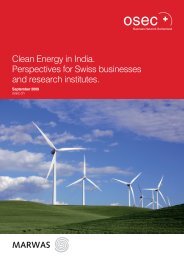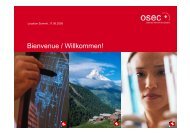Doing Business with Romania - Über die Osec
Doing Business with Romania - Über die Osec
Doing Business with Romania - Über die Osec
- TAGS
- romania
- osec
- www.osec.ch
Create successful ePaper yourself
Turn your PDF publications into a flip-book with our unique Google optimized e-Paper software.
� Inflation issues<br />
o The National Bank of <strong>Romania</strong> (NBR – <strong>Romania</strong>’s Central Bank) shifted to direct inflation<br />
targeting in August 2005. This monetary policy strategy was adopted after completing a<br />
preparatory process, whose last stage consisted in setting up and testing of the economic<br />
analysis and monetary policy decision framework specific to inflation targeting. The other<br />
prerequisites and criteria that are conditional to the effectiveness of this strategy were also fulfilled<br />
(see Attachment 5).<br />
o Concrete impacts on business development: uncertainties, as far as ROL is concerned, as well as<br />
future value of the invested capital.<br />
o Given the ongoing disinflation process in the domestic economy - a sustainable inflation rate over<br />
the medium term in line <strong>with</strong> the quantitative definition of price stability has yet to be attained -<br />
inflation targets are formulated on an annual basis (December/December) and are set over a twoyear<br />
horizon.<br />
For a more detailed analysis of the inflation impact on the national economy see the Central Bank’s<br />
Inflation Annual Report http://www.bnro.ro/PublicationDocuments.aspx?icid=6876<br />
Inflation – see<br />
o http://www.bnro.ro/Direct-Inflation-Targeting-3646.aspx<br />
o http://www.bnro.ro/Characteristics-3653.aspx<br />
o http://www.bnro.ro/Inflation-Targets-3241.aspx<br />
o http://www.bnro.ro/NBR-Projections-4353.aspx<br />
o http://www.bnro.ro/page.aspx?prid=3493<br />
o http://www.bnro.ro/Inflation-Reports-3343.aspx<br />
o http://epp.eurostat.ec.europa.eu/tgm/web/_download/Eurostat_Table_tsieb060HTMLDesc.htm<br />
� Shift to the Euro<br />
o Adoption of the euro foreseen earliest for the 01.01.2015;<br />
o General conditions to enter the eurozone – the five convergence criteria<br />
Figure 1. The convergence criteria for joining the Euro zone<br />
What is<br />
measured:<br />
How it is<br />
measured:<br />
Convergence<br />
criteria:<br />
Price stability<br />
Consumer<br />
price inflation<br />
rate<br />
Not more than<br />
1.5 percentage<br />
points above<br />
the rate of the<br />
three best<br />
performing<br />
Member States<br />
Sound public<br />
finances<br />
Government<br />
deficit as %<br />
of GDP<br />
Reference<br />
value: not<br />
more than<br />
3%<br />
25<br />
Sustainable<br />
public<br />
finances<br />
Government<br />
debt as % of<br />
GDP<br />
Reference<br />
value: not<br />
more than<br />
60%<br />
Durability of<br />
convergence<br />
Long-term interest<br />
rate<br />
Not more than 2<br />
percentage points<br />
above the rate of<br />
the three best<br />
performing<br />
Member States in<br />
terms of price<br />
stability<br />
Source: http://ec.europa.eu/economy_finance/euro/adoption/who_can_join/index_en.htm<br />
Exchange rate<br />
stability<br />
Deviation from<br />
a central rate<br />
Participation in<br />
ERM II for at<br />
least 2 years<br />
<strong>with</strong>out severe<br />
tensions<br />
Comments – <strong>Romania</strong> is still far from fulfilling these conditions and the recent financial problems made<br />
this objective less important for the moment. It is said that the fast recovery from the crisis will increase<br />
chances to entry to the eurozone. The euro will be an objective for BNR but it is important not to obstruct<br />
the country’s development which sometimes requires inflation and governmental debt.




